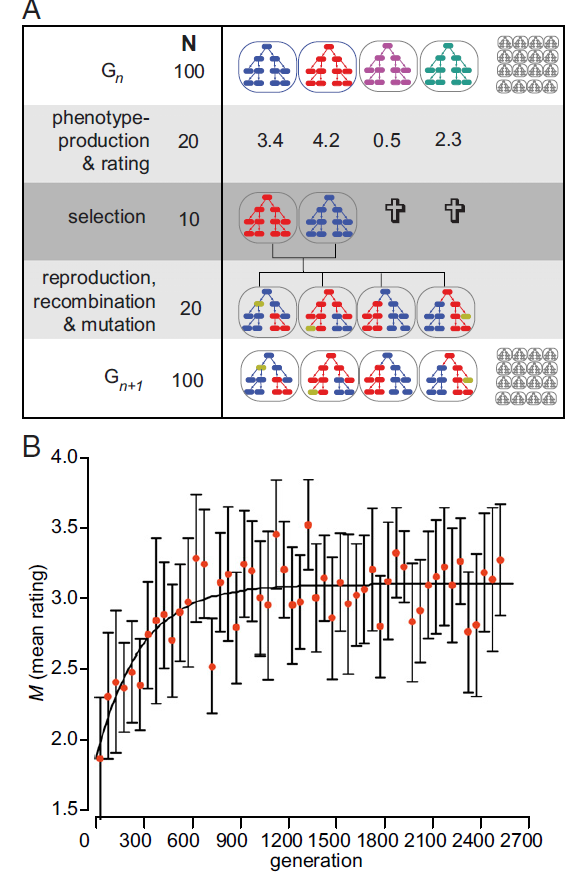The Evolution of Music
![]()
A collaboration between a group in Imperial College and Media Interaction group in Japan yielded a really cool website: darwintunes.org. The idea is to apply Darwinian-like selection to music. Starting form a garble, after several generations producing something that is actually melodic and listen-able. Or a Katy Perry tune. Whatever. The selective force being the appeal of the tune to the listener. From the paper published yesterday in PNAS:
The processes underlying a single DarwinTunes population
are shown in Fig. 1A. At any given time, a DarwinTunes population
has 100 loops, each of which is 8 s long. Consumers rate
them on a five-point scale (“I can’t stand it” to “I love it”) as they
are streamed in random order. When 20 loops have been rated,
truncation selection is applied whereby the best 10 loops are
paired, recombine, and have two daughters each.

Fig. 1. (A) Evolutionary processes in DarwinTunes. Songs are represented as tree-like structures of code. Each generation starts with 100 songs; however, for clarity, we only follow one-fifth of them. Twenty songs are randomly presented to listeners for rating, and the remaining 80 survive until the next generation; thus, at any time, the population contains songs of varying age. Of the 20 rated songs, the 10 best reproduce and the 10 worst die. Reproductives are paired and produce four progeny to replace themselves and the dead in the next generation. The daughters’ genomes are formed from their parents’ genomes, subject to recombination and mutation. (B) Evolution of musical appeal. During the evolution of our populations, listeners could only listen to, and rate, songs that belonged to one or, at best, consecutive generations. Here, they were asked to listen to, and rate, a random sample of all the songs that had previously evolved in the public population, EP1. Thus, these ratings can be used to estimate the mean absolute musical appeal, M, of the population at any time. To describe the evolution of M, we fitted an exponential function. Because the parameter that describes the rate of increase of M is significantly greater than zero, M increases over the course of the experiment
Great. This blog is about biology and music, I think this is the first post I actually had both together. Nothing more to say, really, except that DarwinTunes is seriously going to ruin my productivity today.
Here are the evolving tunes. From the atonal generation 0 to the rather palatable, if somewhat dull, last generation (3630 as of this writing):
Robert M. MacCallum, Matthias Mauchb, Austin Burta, & Armand M. Leroia (2012). (2012-06-18) Evolution of music by public choice. Proceedings of the National Academy of Sciences DOI: 10.1073/pnas.1203182109



















I found their work very interesting, but it fits more into computational evolutionary design than it does evolutionary studies of culture. The major reason for this is that their process of evolution was too teleological to be analogous to natural evolution, even in memes. In this way, it’s comparable to human-driven artificial selection, as with plants and farm animals.
The problem with using it to study cultural development is that, unlike in culture, there was an end-goal in mind (perceived pleasantness), and that goal was pre-determined by the participants already developed tastes. This paradigm lacks any possibility to account for the emergence of *new* trends and tastes because cultural evolution is not random, and its selective pressure has rarely been the prevailing tastes of contemporary society (in fact, most cultural innovations tend to meet with displeasure until a generation or two after they appear).